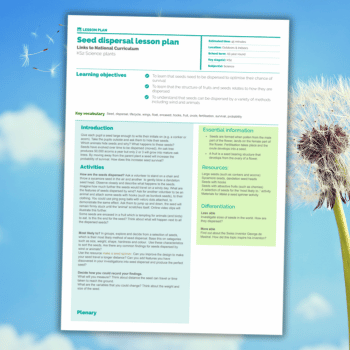In this KS2 seed dispersal lesson, students will learn that seeds need to be dispersed to optimise their chance of survival.
They will look at the structure of fruits and seeds relates to how they are dispersed, and understand that seeds can be dispersed by a variety of methods including wind and animals.
KS2 seed dispersal starter activity
Which animals hide seeds and why? What happens to these seeds? Seeds have evolved over time to be dispersed (moved).
An oak tree produces 50,000 acorns a year but only 2 or 3 will grow into mature oak trees. By moving away from the parent plant a seed will increase the probability of survival. How does this increase seed survival?
Ask a volunteer to stand on a chair and throw a sycamore seed in the air and another to gently blow a dandelion seed head.
Observe closely and describe what happens to the seeds. Imagine how much further the seeds would travel on a windy day. What are the features of seeds dispersed by wind?
Ask for another volunteer to be an animal and attach some seeds with hooks (such as burdock seeds), to their clothing. You could use ping pong balls with velcro dots attached, to demonstrate the same effect.
Ask them to jump up and down, the seed will remain firmly stuck until the ‘animal’ scratches itself. Online video clips will illustrate this further.
Some seeds are encased in a fruit which is tempting for animals (and birds) to eat. Is this the end for the seed? Think about what will happen next to all the dispersed seeds.
The Royal Horticultural Society is a charity established to share the best in gardening. It aims to enrich everyone’s life through plants, and make the UK a greener and more-beautiful place. Get more great resources from the RHS. Visit schoolgardening.rhs.org.uk/home. You can also follow on X at @The_RHS.











